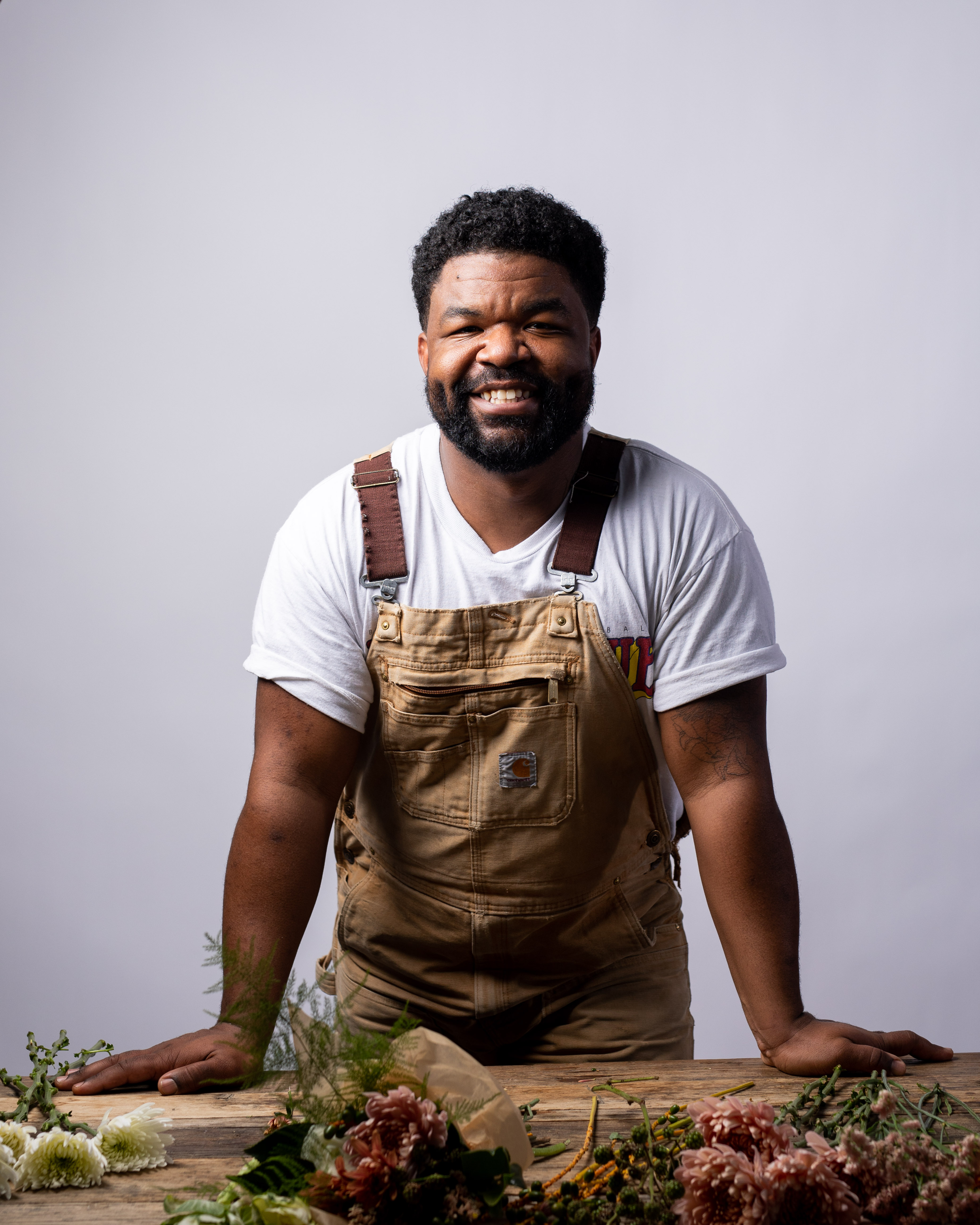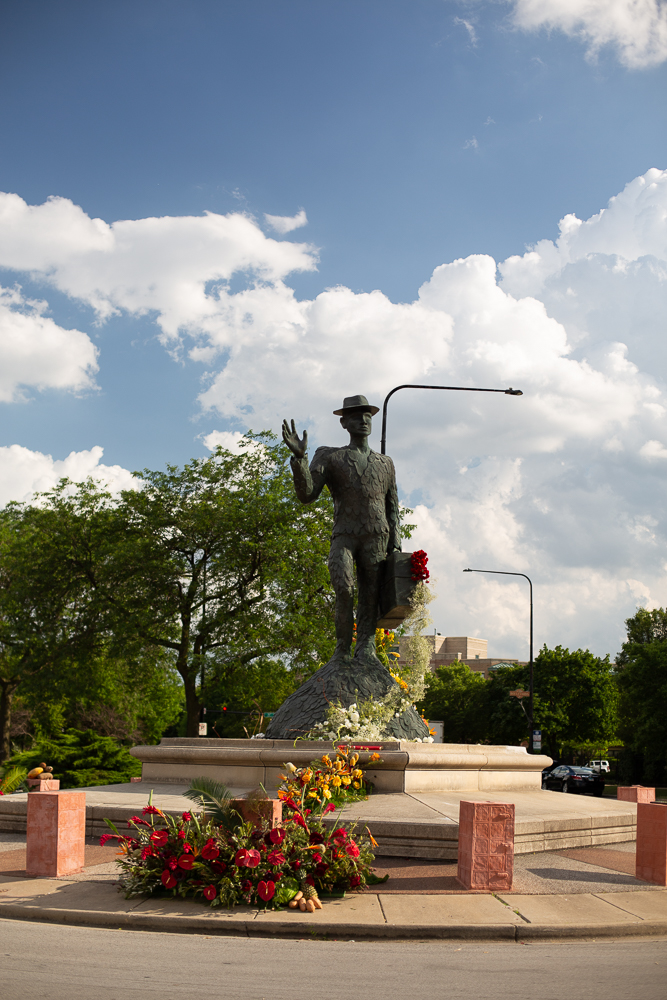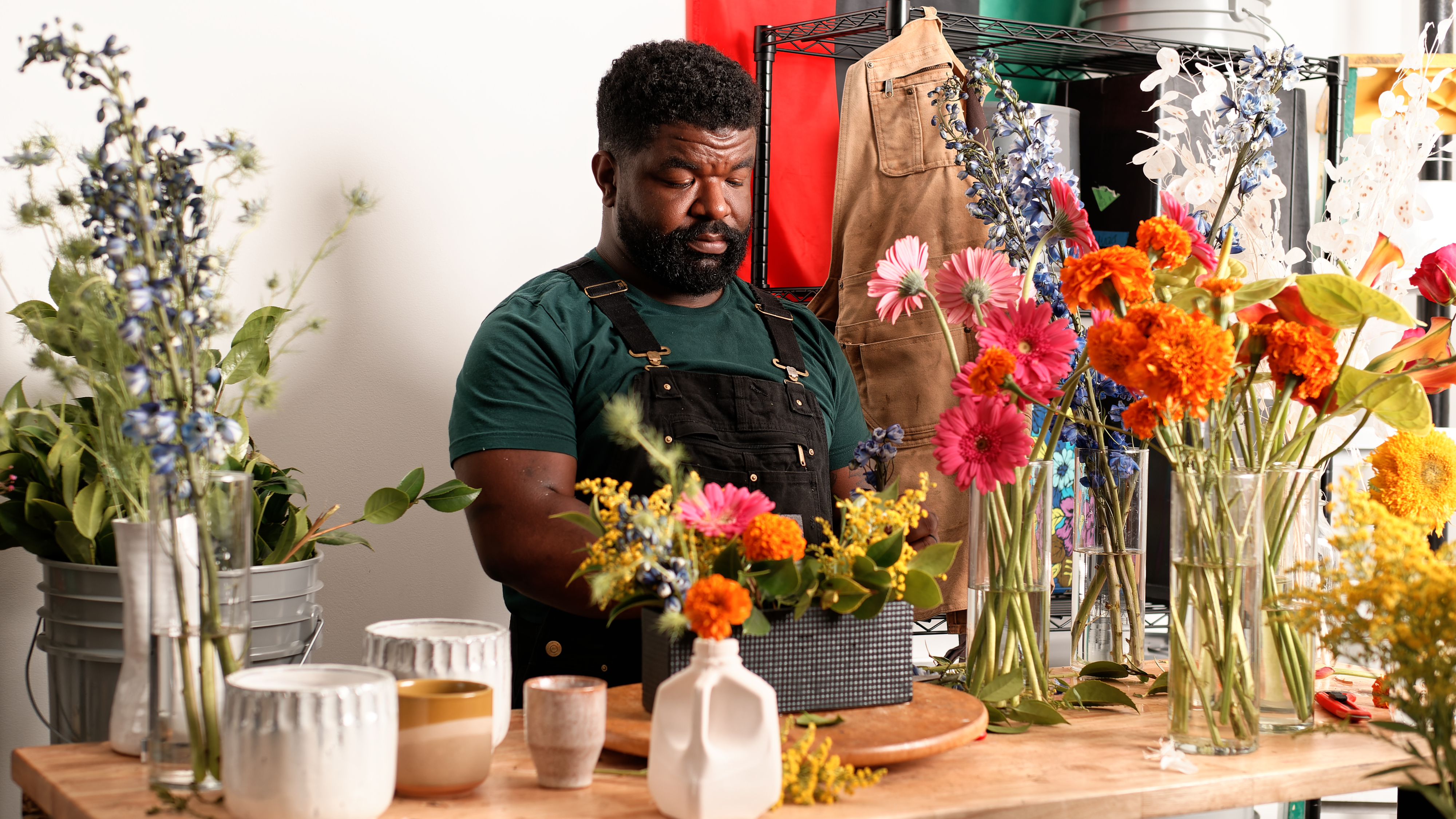John Caleb Pendleton learned to arrange flowers as a creative outlet and a way to support his mental health. Now, his floral art and installations inform a movement for Black justice, memory, triumph, and joy.
“Black joy means defiance, resilience, exuberance. It also means innovation.” John Caleb Pendleton is the founder and creative director of the Chicago-based floral company Planks & Pistils. Black joy is a sign, he tells Design Observer from his studio in Chicago’s Pilsen neighborhood. “For Black people, when we’re joyful … something new is about to come out. You know something special is going to come out.”
Signs of joy — and innovation — are all around if you know where to look. “To me, it looks like community,” he says. “Like Black folks gathering together, laughing, around food.”
Pendleton’s story and his joy began in Grove Hill, Alabama. The name of his studio is a tribute to his parents: His father’s woodworking business (planks) and his mother’s adoration of flowers (pistils). Pendleton’s go-to work uniform, his signature Carhartt brown overalls, is a nod to his working-class background. His great-great-grandparents were sharecroppers. His maternal grandmother was a janitor at his middle school.

Photo credit: Khalid Ibrahim, @eatpomegranate

His art, he says, is for them. For his grandparents, for his ancestors — and for ours.
“My story is just a Black story,” he says. “When you look at all of these classical paintings, they’re just paintings of European people living their life doing whatever they did. With my art, I’m just showing my people and how we do it.”
Flowers with a Black voice
Pendleton's first installation was unveiled on February 1, 2020, in honor of Black History Month. He brought roses, carnations, and palm branches to the John Baptiste Pointe DuSable bust in downtown Chicago and included a small piece of wood with the words “a Black man founded Chicago” burned on it.
That summer, he created a tribute to Breonna Taylor, who was killed by police in 2020 in a botched raid on her apartment, to mark what would have been her 27th birthday. It was a watershed work in which his skills as a floral storyteller were in full bloom.
“There’s a way to tell stories with flowers — looking up different colors that have to do with the Haitian flag [for the DuSable bust]; looking up the state flower for Kentucky, where Breonna Taylor was from,” Pendleton says. When he researched the origin of “Breonna,” he discovered it meant “noble, strong, and prestigious,” so he arranged the flowers in the pattern of Dewnnimmen, the Adinkra symbol for strength (popular in Ghana).
The center of the installation was filled with rose petals, a nod to a song by musical artist Dee Wilson of Common Hymnal, a collective of Christian creatives. The song, aptly named “Rose Petals,” functions as a tribute and a reminder. “But look at all these roses/With petals on the ground/They called this one Mike Brown,” sings Wilson in the chorus, and then lists the names of Black people who died as a result of police violence.
Pendleton installed the work at the Gwendolyn Brooks: The Oracle of Bronzeville, a monument created by artist Margot McMahon in Chicago’s Kenwood neighborhood, and played the song at the opening ceremony. “It was a very simple installation, but it was really beautiful, and that was a beautiful song,” he says.
Using flowers to tell more complex stories
In 2021, Pendleton created an installation that depicted the Transatlantic Slave Trade and was hosted by the South Side Community Art Center in Chicago. It added an element of experiential design that would become an important feature in much of his future work.
“It was an interactive piece to communicate how it took one ancestor making it through the Middle Passage for us to get here today,” he explained in an Instagram caption. “We encouraged people to grab a stem, take it, and dry it, and by the end of the weekend, it was pretty empty. Beneath the arrangement, we had a tank of water with hand ties submerged into it to represent all those that were lost and whose bodies found their final resting place at the bottom of the Atlantic Ocean.”
Last year, Pendleton paid homage to a little-remembered tradition: the horse-drawn Juneteenth carriages that were used in local communities to celebrate the Emancipation Jubilees marking the end of chattel slavery. The 19th-century versions were typically adorned with flowers and plants, but Pendleton cheekily deployed a 1976 Cadillac Eldorado carrying a mix of traditional flowers, such as roses and baby’s breath, and tropical flowers, such as birds of paradise, flowering ginger, and protea.
.jpg)
“I ended up calling that installation ‘An Ode to Black Millennials,’” Pendleton says. “The back of the car represents the history and the baggage that Black folks carry with us, and the front of the car represents the future we’re moving into.” Navigating the tension between the past and the future is the work facing younger generations, he says.
A second Juneteenth performance piece, called “All These Weeks,” highlighted the 128 weeks it took for news of the Emancipation Proclamation to reach enslaved people in Galveston, Texas. Pendleton passed out 128 hand-tied bouquets to passersby; when the bouquets were gone, all that was left of the installation was some baby’s breath, cotton, wires, and chains.
These types of emotional beats — part spectacle, part performance, part audience participation — are what he hopes will leave a lasting impact on viewers. “It’s morphed into thinking about how I can tell stories in more complex ways,” Pendleton says. “Like Toni Morrison knows how to tell a story in a complex way. Someone can read it and the surface of the story, but if you have the eyes to see and the understanding to know, you can get real deep and real complex.”

Black men deserve their flowers
Pendleton’s life continues to reflect the complexity of the Black story in America.
It’s not common to see Black men in floral spaces, he says. He’s still sometimes mistaken for an employee while shopping at a members-only wholesale market for the rare flowers he uses in his arrangements. But he’s optimistic that as Black men embrace their creativity and vulnerability, they will find a more welcoming world.
To help the cause, Pendleton has partnered with Black Men Flower Project, a nonprofit dedicated to celebrating the beauty of Black masculinity and the power of community. The mechanism is delightfully simple: Black men nominate each other to receive a professionally designed flower arrangement, conceived specifically for them. In a culture where Black men have learned to expect flowers only at their funerals, getting them while they’re still alive is a radical act of connection. “Flowers have been a healing space for me," Pendleton told People. “I want other Black men to experience that.”

Photo credit: Jack Li, @jackxphotos
For Pendleton, the healing continues. His art has been the gateway to better understanding the nature of the human experience, a journey of quiet joy.
“Even though I can design quickly, flowers force me to slow down in a way I don’t normally live my life,” he says. “It makes me ponder beauty. I’ve experienced a lot of grief in my life, and interacting with flowers is really understanding the brevity of life. Our life is like flowers: here today and gone tomorrow.”
John Caleb Pendleton’s work has been featured in museums and fashion shows. Pendleton will mount his first solo art show in 2025, featuring 16 pieces, including dried and fresh floral arrangements, woodwork, and photography. Follow him on Instagram.
